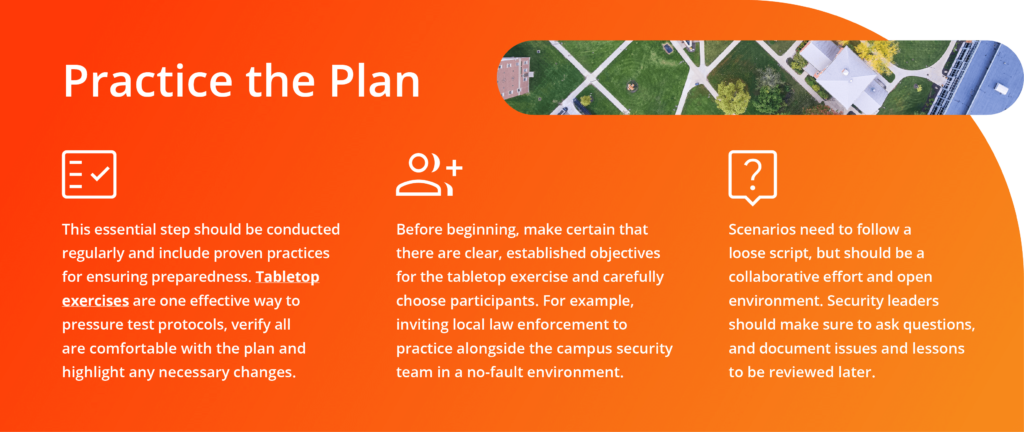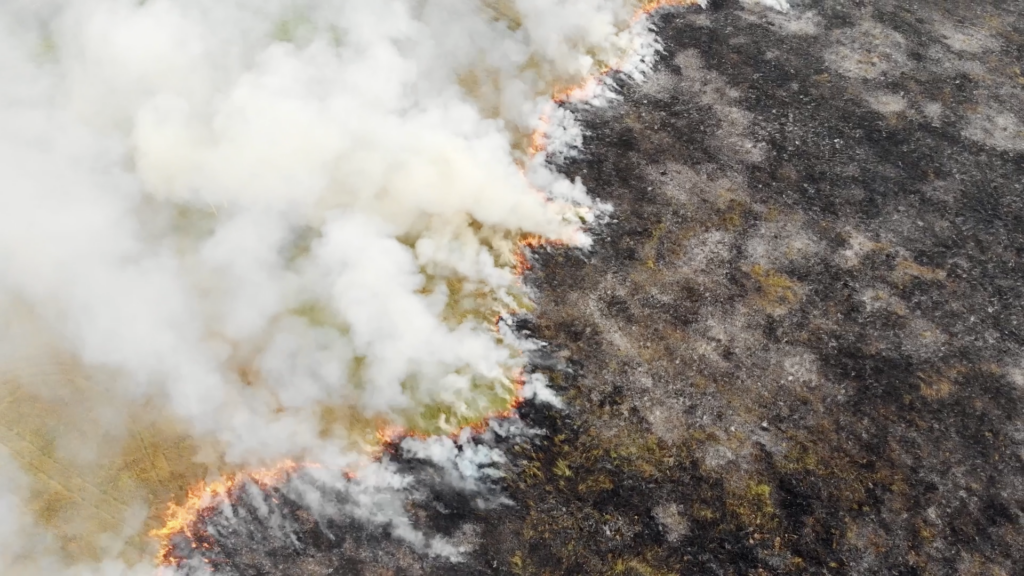In 2021, UNESCO estimated there were 6.4 million internationally mobile higher education students studying abroad, conducting research, taking short-term classes and participating in other educational experiences in foreign countries. While living in a different country can be an enriching and exciting adventure for students, it introduces unique security challenges for security leaders responsible for safeguarding colleges and universities.
For example, the COVID-19 pandemic highlighted an obvious need for security leaders to be able to communicate with and recall students from campuses abroad. But the purview of these leaders is vast. They are responsible for everything from gathering routine information about local crime statistics to figuring out where to send students after a gas line explosion damaged their academic building.
Today’s higher-ed security leaders need to also consider how to protect campuses, students, faculty and staff in a world where risks and threats are increasingly unpredictable and more frequent than ever—including geopolitical conflicts, extreme weather, transportation strikes, and the recent return to large-scale events.
This calls for security leaders to revisit their incident response playbooks. Here we outline several ways to do so, including considerations and recommendations specific to higher education.
4 of the Top 10 Risks in Higher Education
The United Educators’ latest survey on the top risks facing colleges and universities, 2023 Top Risks Report: Insights for Higher Education, shows that many schools frame mental health as a risk and that 15% are concerned about external pressures beyond their control, such as economic, political and cultural stressors.
Data security
Student mental health
Facilities and deferred maintenance
External pressures
Getting Started: Reassess Playbook Basics
Security leaders will face different risks and threats depending on the makeup of their institution. However, there are a number of key plans and strategies that every higher-ed security leader needs to be aware of when it comes to planning for and responding to risks, regardless of the type.
Identify unique threats
Conducting a hazard identification risk assessment can be an effective starting point for security leaders looking to identify broad threats to a campus. But there is no one-size fits all solution. Higher-ed security leaders must be sure to account for the risks and hazards unique to their geography, campus community and institution.
For example, a school with a large sports stadium must consider the traffic implications of people attending games. A coastal university, on the other hand, will always have to take potential flooding risks into account.
To start, security leaders should create a list of the top 10 potential emergencies that are specific to their school and community, including standard operating procedures (SOPs) and granular instructions for each.
What we find useful is having what we call emergency sub plans for each specific type of emergency that we might face.
Rob Kilfoyle, Director of Public Safety & Emergency Management, Humber College in Toronto, Canada
Communicate with the campus community
Whether it’s to bring students and faculty back to their home country, direct them to a shelter or advise the community to avoid a certain area, clear and effective communication is key during an emergency. Be sure to include these two key components in your communication plan:
No.1: Communication protocols
For each potential scenario, decide who to notify, when to notify and how to notify. The type of incident will help determine how the information is disseminated and to whom. For example, an active shooter would be broadcast across all communications channels, while a power outage might only warrant a notification via an app.
Consider how best to notify students on home campus versus those abroad—or any scenario that would require notifying every member of the campus community.
- Pro Tip: Avoid overloading the community with messages to prevent important information from being overlooked.
No. 2: Mass communication systems
A campus-wide mass notification system will look different depending on the school. However, it can include outdoor speakers, digital signage, campus TVs, computer monitors, emails, texts, and updates to social media platforms about incidents impacting campus. Some schools also have safety apps that can push notifications.

5 Campus Security Risks to Add to the Playbook
When revisiting your security incident playbook, be sure that the following five common risks and events are included. While higher-ed security leaders might not encounter each one, it’s likely that they will experience no less than two. We’ve outlined them below along with key considerations for each.
No. 1: Study abroad campuses or trips
While it can be complicated to monitor all travel to remote towns or bustling cities, security leaders must be aware of developing or potential situations in all countries and cities in which they have students and faculty.
For example, in 2023 Chinese students studying in Australia experienced a series of “virtual kidnappings” where scammers extorted students for money before forcing them to fake their own kidnappings and asking their families for ransom money.
Beyond headline-grabbing news events, security leaders need constant critical insight into what’s happening in the day-to-day life of the city. For example, receiving information about daily crime rates in popular student areas of Amsterdam.
Security leaders are often also responsible for ensuring safe travel for faculty—including those who need to work in high-risk locations.
What to consider
- Create a communications model to quickly message travelers abroad
- Aggregate important and up-to-date information about each locality to flag potential issues
- Consider how to balance the risk of travel with enabling faculty to conduct necessary research in potentially risky geographies
No. 2: Large-scale events
Colleges and universities often serve as cultural centers for the surrounding areas, hosting concerts, sports, festivals, theater and other large-scale events. The sheer number of people attending these events can raise the stakes and introduce a multitude of security challenges.
For example, fall at Baylor University in Waco, Texas, is all about football, which means tens of thousands of people converge on campus throughout the four-month football season. The university’s director of global safety and security works with local, state and federal partners to ensure the events are as safe as possible. This includes managing hundreds of medical calls each game due to the Texas heat.
For colleges in densely populated areas or near critical junctions like Baylor University’s stadium—which sits on a major highway—the security team needs constant updates on potential traffic issues or road shutdowns. Updated information enables the team to effectively funnel spectators out of large-scale events with limited impact on local traffic.
What to consider
- Develop a plan to elevate threats depending on weather/situation (i.e. heat exhaustion during a summer football game or cold-related injuries during winter weather)
- Work with local, state and federal partners prior to the season or event
- Be aware of how large groups of people will affect and be affected by local traffic (including those who simply live in the area)

3 Key Steps to Prepare for and Secure Large-scale Events
Know the three must-haves for securing large-scale, in-person events: pre-planning, operational management and post-event audit.
Read NowNo. 3: Visiting dignitaries
College and university campuses often host a variety of political figures and dignitaries. Ensuring campus safety while working with guests’ assigned security details and law enforcement creates additional complexities for security leaders.
While security plans for such visits are often worked on for weeks or months in advance, they can also change quickly. That requires a thorough understanding of overarching goals and objectives for the visit as well as knowledge of any existing threats.
During such visits, security teams should focus on coordinating and facilitating entrances and exits as well as safe zones in the event of a threat or concern. The goal of the security leaders should remain focused on ensuring the safety of the overall campus population, but balance that with specific requirements of the visiting guests.
What to consider
- Develop a plan that enables your team to work with security details
- Facilitate easy entrances/exits for the visitor so the focus can remain on the larger crowd
No. 4: Weather emergencies
Increasing amounts and severity of weather events mean that security leaders must plan ahead for potential risks in a few different ways. This can be complex depending on the type of weather events, and considering security leaders are responsible for both the physical safety of each person as well as the physical infrastructure that may be impacted by impending weather.
Using weather services and local meteorologists alongside federal emergency management can provide accurate forecasting for severe thunderstorms, tornadoes or winter weather advisories. Updated information about flooding, downed trees, power line or tornado damage can offer a preview of potential impacts of incoming weather systems.
What to consider
- Pay attention to systems like National Weather Service as well as self-reporting on social media
- Develop relationships with local meteorologists for the most accurate localized weather
- Identify risks proactively. Ensure you have access to real-time breaking news alerts to gain an early line of sight into major storms and respond more quickly and efficiently.

Understand and Plan for Extreme Weather
Explore how different extreme weather events have varied lead times—long, short and little to none—and how those differences affect preparedness measures and what to consider when mitigating potential effects.
Learn MoreNo. 5: Health emergencies
Although the COVID-19 pandemic serves as the most recent and prime example of the importance of planning ahead for health emergencies, the reality is that most colleges and universities have long had to manage health concerns—just on a smaller scale.
Whether or not they do so effectively depends on the school and the issue at hand. For example, a norovirus outbreak at a Canadian university two years prior to COVID-19 highlighted the flaws in the school’s established health protocols and plan.
Organizations should draw on both their own lessons learned as well as from the pandemic, such as:
- Establishing lines of communication with both on-campus experts (i.e. health science programs) or off campus experts (local infectious disease doctors)—both can supply vital information
- Implementing effective cleaning protocols, social distancing and masking
- Tracking vaccinations and combining that with technology, like safety apps, for better accuracy and planning
COVID-19 also highlighted the need for colleges and universities to institute a variety of other physical security protocols like limiting entry and exit points and establishing extra clinics capable of large scale testing and vaccinations.
What to consider
- Iterate health emergency playbooks based on experiences from previous events
- Establish a clear chain of command, including who is responsible for providing direction (i.e. local health authorities, federal partners)
- Use campus resources when appropriate, such as healthcare centers, or life sciences or medical programs
Higher-ed security leaders play a vital role in safeguarding campus communities. Amid a dynamic global landscape, they must continuously iterate on their playbooks—including proactive measures and tailored emergency plans—to ensure the safety and security of students and faculty alike.

First Alert
Get a firsthand look at how higher-ed institutions use First Alert, Dataminr’s product for the public sector, respond to and mitigate security risks and challenges faster and more effectively.
Request a Demo


